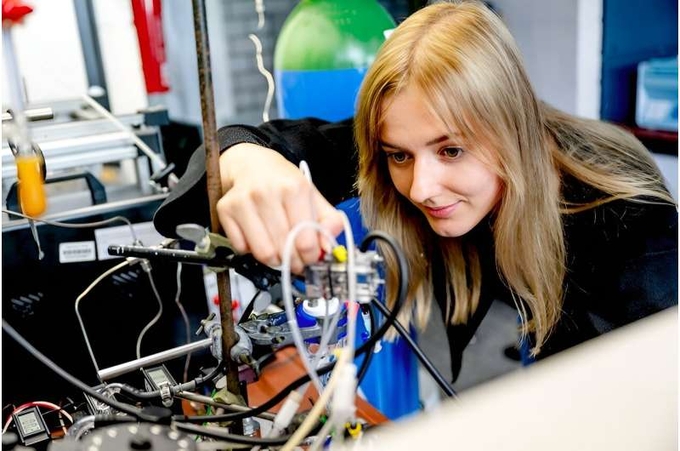November 28, 2025 | 04:56 GMT +7
November 28, 2025 | 04:56 GMT +7
Hotline: 0913.378.918
November 28, 2025 | 04:56 GMT +7
Hotline: 0913.378.918
The production of hydrogen and the production of fertilizer have so far been separate chemical processes.

“We first had to bridge a thermodynamic Grand Canyon,” explains Ieva Cechanaviciute the challenge of the study. Credit: UB, Marquard.
With the new approach, the team from Ruhr University Bochum and the University of Duisburg-Essen demonstrates that the two can be combined on a laboratory scale. The Bochum-based group led by Ieva Cechanaviciute and Professor Wolfgang Schuhmann reports on the results, with Bhawana Kumari and Professor Corina Andronescu from the University of Duisburg-Essen, in the journal Angewandte Chemie International Edition on 23 June 2024.
Hydrogen can be produced by splitting water (H2O) into hydrogen (H2) and oxygen (O2) using electrical energy. To make this process sustainable, the energy should come from renewable sources.
"This can only be done in a country where there is plenty of space for wind power and lots of sun for photovoltaics, for example in Namibia," explains Schuhmann.
In order to build an economy based on hydrogen in Germany, it must therefore be imported from distant countries. The crux of the matter is that a lot of energy is needed to liquefy hydrogen for transport, as it only becomes liquid at extremely low temperatures of minus 253 degrees Celsius or high pressures.
Alternative concepts therefore envisage converting hydrogen into ammonia at the production site, as this becomes liquid at minus 33 degrees Celsius. It also has a higher energy density.
"A tanker full of liquid ammonia would transport around 2.5 times more energy than a tanker full of liquid hydrogen," explains Schuhmann.
Finally, ammonia would have to be converted back into hydrogen at the point of use. This is usually done using the reverse Haber-Bosch reaction, in which ammonia (NH3) is converted into nitrogen (N2) and hydrogen (H2). Of the two products, however, only the hydrogen can be utilized profitably.
"We therefore had the idea of combining the reverse Haber-Bosch reaction with a second electrolysis of water to produce a product that can easily be used for the production of fertilizer, such as nitrite or nitrate, instead of nitrogen," explains Ieva Cechanaviciute.
In this reaction, ammonia (NH3) and water (H2O) are consumed to produce nitrite (NO2-) and hydrogen (H2). In contrast to the reverse Haber-Bosch reaction, the hydrogen output is doubled and instead of non usable nitrogen, mainly nitrite is produced, which can be further processed into fertilizer.
For the reaction, the team used gas diffusion electrodes into which ammonia can be fed as a gas. "This had never been done before," explains Schuhmann. "Ammonia was always used in dissolved form."
One challenge for the researchers was to find a suitable catalyst with which their idea could be realized. This is because the starting material NH3 tends to convert into nitrogen due to the very strong nitrogen-nitrogen triple bond and not into nitrite.
"We first had to bridge this thermodynamic Grand Canyon," explains Cechanaviciute. In earlier work, the team had already experimented with multi-metal catalysts, which proved to be suitable for this purpose. They were able to convert 87% of the transferred electrons into nitrite. The team also managed to avoid oxygen as an undesirable by-product of water electrolysis.
"Our work shows that our Gedankenexperiment can work in principle," summarizes Schuhmann. "But we are still a long way from technical implementation on an industrial scale."
(Phys.org)

(VAN) A new study reveals how the simultaneous effects of ocean acidification, salinity and loss of oxygen are making the world more fragile.

(VAN) Hopes are growing that the creation of the first 3D turkey gut model could be a turning point in the battle against the virulent blackhead disease.

(VAN) Tyson, America’s biggest meat supplier, plans to shutter one of its largest beef processing plants as the industry continues to struggle with low cattle supplies and political pressure from Washington.

(VAN) New FAO study shows how digital solutions are empowering farmers and fishers to prevent losses and build resilient agrifood systems.

(VAN) Brazil's COP30 presidency pushed through a compromise climate deal on Saturday that would boost finance for poor nations coping with global warming but that omitted any mention of the fossil fuels driving it.

(VAN) Poultry farmers in the UK have been warned that they could face one of the worst winters yet for bird flu.

(VAN) Prices of main-crop paddy have risen sharply, with jasmine rice hitting 16,100 baht per tonne — the highest level in years.